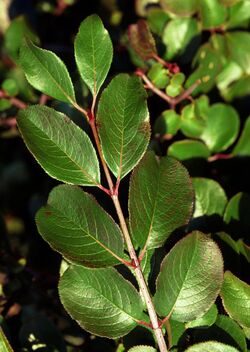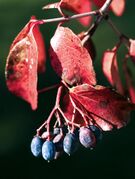Biology:Viburnum rufidulum
| Viburnum rufidulum | |
|---|---|

| |
| Scientific classification | |
| Kingdom: | Plantae |
| Clade: | Tracheophytes |
| Clade: | Angiosperms |
| Clade: | Eudicots |
| Clade: | Asterids |
| Order: | Dipsacales |
| Family: | Adoxaceae |
| Genus: | Viburnum |
| Species: | V. rufidulum
|
| Binomial name | |
| Viburnum rufidulum | |

| |
| Generalized natural range of Viburnum rufidulum | |
Viburnum rufidulum, also known as the rusty blackhaw,[2] blue haw,[2] rusty nanny-berry,[2] or southern black haw,[2] is a flowering species of shrub or small tree that is common in parts of the Eastern and Central United States .[3][4] It produces attractive flowers and fall foliage, as well as fruits that are popular with some species of bird.
Description
Leathery deciduous leaves are simple and grow in opposite blades ranging from 0.5-3 inches in length and 1-1.5 inches in width.[3][4] Petioles are "rusty hairy" with grooves and sometimes wings.[4] Leaf margins are serrate.[3] Autumn leaf colors are bronze to red.[4]
Twigs range in color from "reddish brown to gray"; young twigs are hairy, and get smoother with age.[4]
Bark is similar that of the flowering dogwood, ranging in color from "reddish brown to almost black" and forming "blocky plates on larger trunks".[4]
Viburnum rufidulum blooms in April to May with creamy white flowers that are bisexual, or perfect and similar to those of other Viburnum species, but with clusters as large as six inches wide.[4]
The fruits are purple or dark blue, glaucous, globose or ellipsoid drupes that mature in mid to late summer.[3][4] The edible fruit[5] has been said to taste like raisins and attract birds.[6]
It is similar to Viburnum prunifolium (blackhaw). Petioles of V. prunifolium do not have the rusty hairs that those of V. rufidulum do.[3]
Distribution
The rusty blackhaw prefers dry habitats with elevations generally below 750 m.[3]
It grows in Alabama, Arkansas, Florida, Georgia, Illinois, Indiana , Kansas , Kentucky, Louisiana, Mississippi, Missouri, North Carolina, Ohio, Oklahoma, South Carolina, Tennessee , Texas , Virginia, and West Virginia.[2][7]
Uses
It is occasionally used as an ornamental plant.[4]
References
- ↑ Botanic Gardens Conservation International (BGCI).; IUCN SSC Global Tree Specialist Group (2019). "Viburnum rufidulum". IUCN Red List of Threatened Species 2019: e.T144048348A149038833. doi:10.2305/IUCN.UK.2019-2.RLTS.T144048348A149038833.en. https://www.iucnredlist.org/species/144048348/149038833. Retrieved 20 November 2021.
- ↑ 2.0 2.1 2.2 2.3 2.4 {{citation | mode = cs1 | title = Viburnum rufidulum | work = Germplasm Resources Information Network (GRIN) | url = | publisher = [[Organization:Agricultural Research ServAgricultural Research Service (ARS), United States Department of Agriculture (USDA) | access-date = 2009-07-29 }}
- ↑ 3.0 3.1 3.2 3.3 3.4 3.5 Duncan, Wilbur H.; Marion B. Duncan (1988). Trees of the Southeastern United States. Athens, Georgia: The University of Georgia Press. pp. 100–102. ISBN 0-8203-1469-2. https://archive.org/details/treesofsoutheast00dunc.
- ↑ 4.0 4.1 4.2 4.3 4.4 4.5 4.6 4.7 4.8 Brown, Claud L.; L. Katherine Kirkman (1990). Trees of Georgia and Adjacent States. Portland, Oregon: Timber Press. pp. 253–254. ISBN 0-88192-148-3.
- ↑ Little, Elbert L. (1980). The Audubon Society Field Guide to North American Trees: Eastern Region. New York: Knopf. p. 676. ISBN 0-394-50760-6.
- ↑ "NPIN:Viburnum rufidulum (Rusty blackhaw viburnum)". Native Plant Database. Lady Bird Johnson Wildflower Center - The University of Texas at Austin. http://www.wildflower.org/plants/result.php?id_plant=viru.
- ↑ "PLANTS Profile for Viburnum rufidulum (rusty blackhaw)". USDA. http://plants.usda.gov/java/profile?symbol=VIRU.
Wikidata ☰ Q7924704 entry
 |




